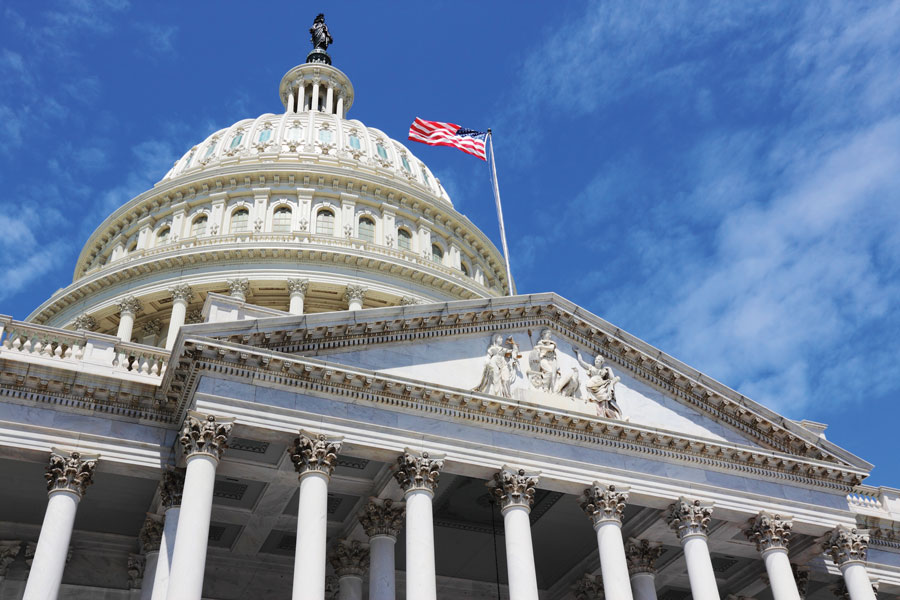

Senate Republicans are preparing to move forward this week with a fiscal framework that would extend expiring tax provisions and boost funding for defense and border security, even as concerns grow over the trajectory of the national debt.
The plan reflects President Donald Trump’s push for a sweeping tax package, which the White House has promoted as “one big, beautiful bill.”
The Wall Street Journal reports that some Republicans are calling for up to $2 trillion in spending cuts over the next decade, but the current Senate proposal leaves those specifics for future negotiations.
“It builds in some flexibility where people feel like we’re still moving forward,” Sen. John Hoeven of North Dakota told the Journal.
The Senate’s strategy to delay detailed decisions on spending cuts is expected to create tension with House Republicans, who are pressing for immediate commitments to reduce outlays. The House’s fiscal framework links at least $1.5 trillion in spending reductions to any tax changes, and leaders have signaled they may oppose any bill that doesn’t do the same.
“There’s high levels of skepticism when people say we’re just writing it for maximum flexibility,” said House Budget Committee Chair Jodey Arrington of Texas. “The Senate’s got to lock themselves in and tie themselves to the mast like we did in the House.”
The Senate aims to vote before Congress adjourns for a two-week recess in April, seeking early legislative momentum without binding itself to controversial cuts. While the current version sets modest minimum spending-reduction targets across committees, it defers broader debates until the final legislation is drafted later this year.
Budget Committee Chair Lindsey Graham of South Carolina, who has prioritized increased funding for border enforcement and the military, emphasized that lawmakers will have a future opportunity to propose specific reductions.
“I don’t want to hear any more about spending cuts,” Graham said. “Those who want to cut spending, there will be a process where you can make your case before the authorizing committee.”
The effort to extend the 2017 Tax Cut and Jobs Act's expiring provisions comes ahead of their scheduled sunset at the end of this year. Republican lawmakers are also considering whether to attach a debt-limit increase to the bill, which could move the timeline up to late summer. They argue that advancing the tax legislation now would provide businesses with greater certainty and allow voters to experience the impact ahead of the 2026 midterm elections.
Democrats, meanwhile, have criticized both the structure of the bill and an anticipated procedural ruling that could allow tax extensions to be scored as revenue-neutral. Opponents argue the approach would primarily benefit high-income taxpayers while putting pressure on programs such as Medicaid.
The fiscal debate unfolds alongside new projections from the Congressional Budget Office, which last week released its updated long-term budget outlook. The report warns that federal debt held by the public is on track to reach 156 percent of gross domestic product by 2055, the highest level in US history. Deficits are projected to remain elevated due to rising interest payments and structural gaps between revenues and spending.
“The latest Long-Term Budget Outlook from CBO paints a stark picture of what is in store unless we get our financial house in order,” Carolyn Bourdeaux, executive director of Concord Action, said in reaction to the CBO's projections. “Congress cannot continue to slash revenues and pretend tax cuts have no cost, while at the same time refusing to address spending in responsible ways.”
The CBO noted that the debt-to-GDP ratio is expected to exceed levels seen during World War II by 2029 and continue rising. The agency also revised its economic forecast downward, citing slower private investment, consumer spending, and labor force growth over the coming decades.

Rajesh Markan earlier this year pleaded guilty to one count of criminal fraud related to his sale of fake investments to 10 clients totaling $2.9 million.

From building trust to steering through emotions and responding to client challenges, new advisors need human skills to shape the future of the advice industry.

"The outcome is correct, but it's disappointing that FINRA had ample opportunity to investigate the merits of clients' allegations in these claims, including the testimony in the three investor arbitrations with hearings," Jeff Erez, a plaintiff's attorney representing a large portion of the Stifel clients, said.

Chair also praised the passage of stablecoin legislation this week.

Maridea Wealth Management's deal in Chicago, Illinois is its first after securing a strategic investment in April.
Orion's Tom Wilson on delivering coordinated, high-touch service in a world where returns alone no longer set you apart.
Barely a decade old, registered index-linked annuities have quickly surged in popularity, thanks to their unique blend of protection and growth potential—an appealing option for investors looking to chart a steadier course through today's choppy market waters, says Myles Lambert, Brighthouse Financial.
